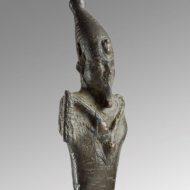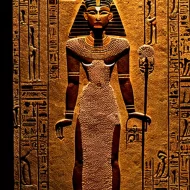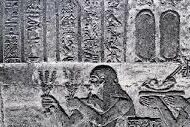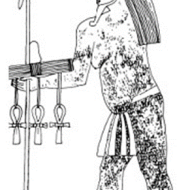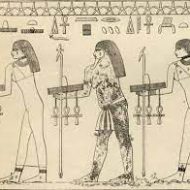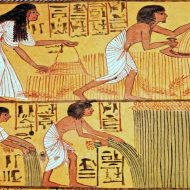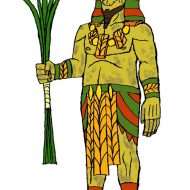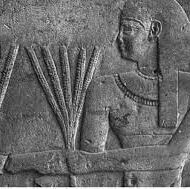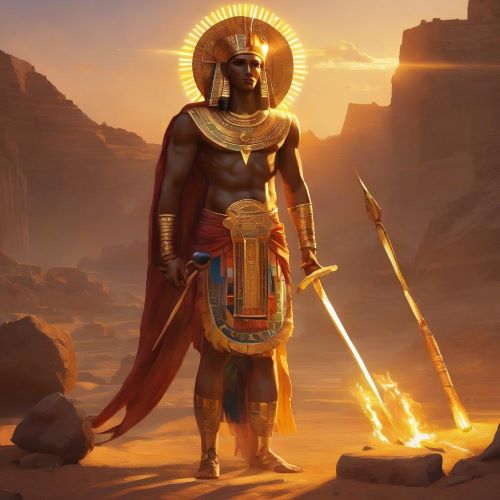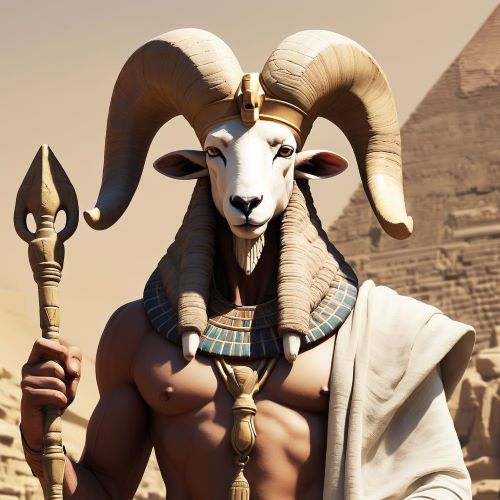Neper : The God of the Grain
Listen
At a glance
| Description | |
|---|---|
| Origin | Egyptian Mythology |
| Classification | Gods |
| Family Members | Nepit, Tayt (Wife), Renenutet (Mother) |
| Region | Egypt |
| Associated With | Grain, Agriculture |
Neper
Introduction
In Egyptian mythology, among the myriad of revered deities, Neper stands as a figure of significance. Revered as the god of grain, he embodies the life force propelling agriculture and nourishment. Often depicted as a youthful entity adorned with symbols emblematic of fertility and abundance, Neper’s portrayal resonates deeply within ancient Egyptian culture, accentuating the paramount importance of agriculture within the Nile Valley civilization. Despite his lesser-known status in comparison to other deities, Neper’s role as the patron of grain and agriculture remains integral. His name, ‘Neper,’ derives from the Egyptian term for ‘grain,’ indicative of his profound association with this fundamental resource. Nestled within the fertile expanses of the Nile Valley, where crops thrived, Neper’s presence ensured prosperity and sustenance for the Egyptian populace. Though the tides of time have eroded his prominence, Neper’s influence in ancient Egyptian religious beliefs endures, symbolizing the vital essence of agriculture in sustaining life.
Physical Traits
Neper’s depiction in ancient Egyptian art reflects his deep connection to the land and its bounty. Often portrayed with black skin reminiscent of the fertile soil along the Nile River, he embodies the essence of fertility and growth. His imagery frequently features him clutching sheaves of grain or wielding a scepter crafted from grain, underscoring his identity as the god of grain. Unlike the imposing stature of deities like Horus or Osiris, Neper assumes a gentler, more youthful form in artistic renderings. Occasionally depicted as a child nestled in the arms of his mother, Renenutet, the goddess of harvest, Neper’s portrayal highlights his nurturing aspect within the pantheon.
The most striking feature of Neper’s representation lies in his association with grain, evident in the intricate details of his attire. Adorned with dots resembling kernels of corn, his clothing serves as a visual testament to his dominion over agriculture. Often depicted scantily clad, Neper’s modest attire perhaps signifies the simplicity and indispensability of his role in sustaining life. His youthful visage exudes serenity, reflecting the cyclical nature of life and the abundance brought forth by the harvest season. Some depictions even portray him with verdant green skin, symbolizing the lush growth of crops and the vitality inherent in nature’s bounty.
Family
Neper’s lineage within Egyptian mythology intertwines with various deities associated with the earth and fertility, underscoring his significance in sustaining life. While specifics regarding his family remain elusive, Neper is often linked with Geb, the earth god, and Osiris, the deity of vegetation and the afterlife, due to their shared domains. Considered the offspring of Geb and Nut, the god and goddess representing earth and sky respectively, Neper’s lineage underscores his pivotal role in ensuring the fecundity and productivity of the land.
Moreover, Neper’s association with Osiris further solidifies his connection to the agricultural cycle, with Osiris’s mythic cycle of death and rebirth mirroring the seasonal rhythms of planting, growth, and harvest. Neper’s familial ties reinforced his role as a patron of agriculture and nourishment. His mother, Renenutet, a revered goddess of harvest and grains, epitomized the cyclical nature of agriculture, while Neper embodied the ongoing cycle of growth.
Debates persist regarding Neper’s paternity, with some sources suggesting Sobek, the crocodile-headed god synonymous with the Nile River, as a potential father figure. This association underscores the Nile’s crucial role as the lifeblood of Egyptian agriculture. Furthermore, Neper’s counterpart, Nepit, the goddess of grain, emphasizes the paramount importance of grain within Egyptian society, while the potential consortship with Tayt, the goddess of weaving, highlights the interconnectedness of grain production and essential facets of life like clothing.
Other names
Neper is recognized by several alternative names and titles, each echoing his pivotal role in agricultural affairs. These appellations include ‘Lord of the Mouth of the River,’ ‘He of the Grain,’ and ‘Lord of Nourishment,’ all of which underscore his crucial function in providing sustenance and abundance to the ancient Egyptian populace. Notably, the etymology of Neper’s name itself holds profound significance, translating to “lord of the mouth,” a poignant reference to the vital role of grain in sustaining life. In ancient Egyptian belief, sustenance extended beyond mere physical nourishment, encompassing the nourishment of the “ren,” an individual’s true name and essence, thereby solidifying Neper’s intrinsic importance within their cosmology.
Additionally, Neper is recognized by alternate names such as Nepra and Nepri, further emphasizing his multifaceted identity and enduring significance within Egyptian culture. These varied epithets serve as poignant reminders of Neper’s omnipresent influence in the realm of agriculture and nourishment, perpetuating his legacy as a benevolent provider and sustainer of life.
Powers and Abilities
Neper, revered as the god of grain in ancient Egyptian mythology, wielded significant influence over agricultural affairs and the prosperity of the land. Farmers invoked Neper’s blessings for bountiful harvests, believing in his ability to nurture the growth of crops such as barley, emmer wheat, and possibly corn. His dominion extended beyond grain to encompass the overall prosperity and abundance of the land, with his powers intertwined with the cyclical rhythms of planting, growth, and harvest.
In Egyptian belief, Neper’s connection with Osiris, the god of the underworld and rebirth, suggests a symbolic association with the cycle of life and death inherent in agricultural practices. Worshipped throughout Egypt, Neper was particularly revered in the fertile regions of the Nile Delta, where rituals and offerings were performed to secure abundant harvests and sustained prosperity. While specific temples dedicated solely to Neper are scarce in archaeological records, it is likely that he featured prominently in agricultural rites conducted at temples dedicated to other deities such as Osiris and Isis.
Modern Day Influence
Despite his once-significant stature, Neper’s influence gradually waned as time progressed. The ascendance of Osiris, revered as a potent deity governing agriculture and rebirth, likely overshadowed Neper’s specific domain. Nevertheless, remnants of Neper’s legacy endured. His enduring association with grain persisted, and depictions of him in certain funerary texts hinted at symbolic representations of continued sustenance in the afterlife.
Although Neper may not command the same recognition today as some of his Egyptian counterparts, his enduring impact reverberates into modern times. The notion of a deity presiding over agriculture and the earth’s abundance resonates across diverse cultures globally. Moreover, the principles of sustainable agriculture and reverence for the earth’s resources mirror Neper’s ancient role within Egyptian society.
While contemporary worship of Neper has waned, echoes of his legacy persist in subtle ways. The intrinsic significance of grain in sustaining human existence serves as a perpetual reminder of agriculture’s foundational importance. Additionally, Neper’s symbolism concerning the cyclical rhythms of growth and harvest underscores the interconnectedness between life and the natural world, offering timeless lessons in environmental stewardship.
Related Images
Frequently Asked Questions
What is lorem Ipsum?
I am text block. Click edit button to change this text. Lorem ipsum dolor sit amet, consectetur adipiscing elit. Ut elit tellus, luctus nec ullamcorper mattis, pulvinar dapibus leo.
What is lorem Ipsum?
I am text block. Click edit button to change this text. Lorem ipsum dolor sit amet, consectetur adipiscing elit. Ut elit tellus, luctus nec ullamcorper mattis, pulvinar dapibus leo.
What is lorem Ipsum?
I am text block. Click edit button to change this text. Lorem ipsum dolor sit amet, consectetur adipiscing elit. Ut elit tellus, luctus nec ullamcorper mattis, pulvinar dapibus leo.
What is lorem Ipsum?
I am text block. Click edit button to change this text. Lorem ipsum dolor sit amet, consectetur adipiscing elit. Ut elit tellus, luctus nec ullamcorper mattis, pulvinar dapibus leo.
What is lorem Ipsum?
I am text block. Click edit button to change this text. Lorem ipsum dolor sit amet, consectetur adipiscing elit. Ut elit tellus, luctus nec ullamcorper mattis, pulvinar dapibus leo.

